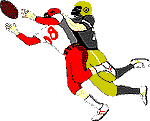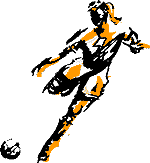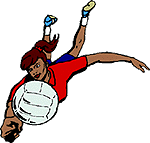|
Here are some details about the injuries associated with each of the
sports. |

| Football
- 63.4% of all reported MTBIs were related to football.
- Players did not return to play for an average of three days.
- The number of MTBIs during games was 11 times higher than during practices.
- Most injuries were associated with tackling or being tackled.
- 14.3% of the MTBIs occurred in linebackers; 14.0% in running backs;
13.4% in offensive linemen.
- Of the 693 different players who suffered an MTBI, 621 players (89.6%)
had only 1 MTBI; 65 players (9.4%) had 2 MTBIs; 6 players (0.9%) had
3 MTBIs and 1 player (0.2%) had 4 MTBIs.
- No deaths were reported.
|
 |
Wrestling
- 10.5% of all reported MTBIs were related to wrestling.
- The number of MTBIs during matches was 3.1 times higher than
during practice.
- Most MTBIs were suffered during takedowns or attempted takedowns.
- Wrestlers did not return to the sport for an average of 2 days after
an MTBI.
|
 |
Basketball
- 4.2% of all reported MTBIs were related to boys' basketball and
5.2% were related to girls' basketball.
- MTBIs occurred more often during games than practice: 4.9 times more
often in boys' games compared to practice; 6.1 times more often in girls'
games compared to practice.
- Collisions between players accounted for most MTBIs. MTBIs were also
suffered by many girls during rebounding.
- Most game-related MTBIs in boys and girls were suffered by guards.
In practice, most MTBIs occurred in forwards.
- Players did not return to play for an average of 2 days.
|
 |
Soccer
- 5.7% of all reported MTBIs were related to boys' soccer and
6.2% were related to girls' soccer.
- In boys' soccer, the injury rate was 16.2 times higher during games
than during practices; in girls' soccer, it was 14.4 times higher during
games than during practices.
- Forwards and halfbacks suffered most of the MTBIs.
- Most MTBIs occurred while heading the ball. However, it is unclear
if player-to-player, player-to-ball or player-to-ground collisions caused
the MTBIs.
- Players did not return to play for an average of 3
days.
|
 |
Baseball and Softball
- 1.2% of all reported MTBIs were related to boys' baseball; 2.1%
were related to girls' softball.
- Most baseball and softball related MTBIs occurred when players
collided with other players, although MTBIs were also sustained by
players from collisions with a bat, during sliding and from being hit by a
pitch.
- Baseball players did not return to play for an average of 3
days; softball players did not return to play for an average of 2
days.
|
 |
Field Hockey
- 1.1% of all reported MTBIs were related to girls' field hockey.
- Games had MTBI rates 14.4 times higher than practices.
- MTBIs occurred from being hit with a hockey stick, hit with a ball and
collsions with other players.
- Players did not return to play for an average of 3
days.
|
 |
Volleyball
- 0.5% of all reported MTBIs were related to girls' volleyball.
- MTBIs occurred from being hit with a ball,
collisions with other players, and during digging.
- Players did not return to play for an average of 1
day.
|
 September 20, 1999
September 20, 1999













 brain injury. It is especially important to monitor and treat people
who suffer MTBIs because injuries to the head may have lasting effects on
memory and learning.
brain injury. It is especially important to monitor and treat people
who suffer MTBIs because injuries to the head may have lasting effects on
memory and learning.
![[email]](./gif/menue.gif)



